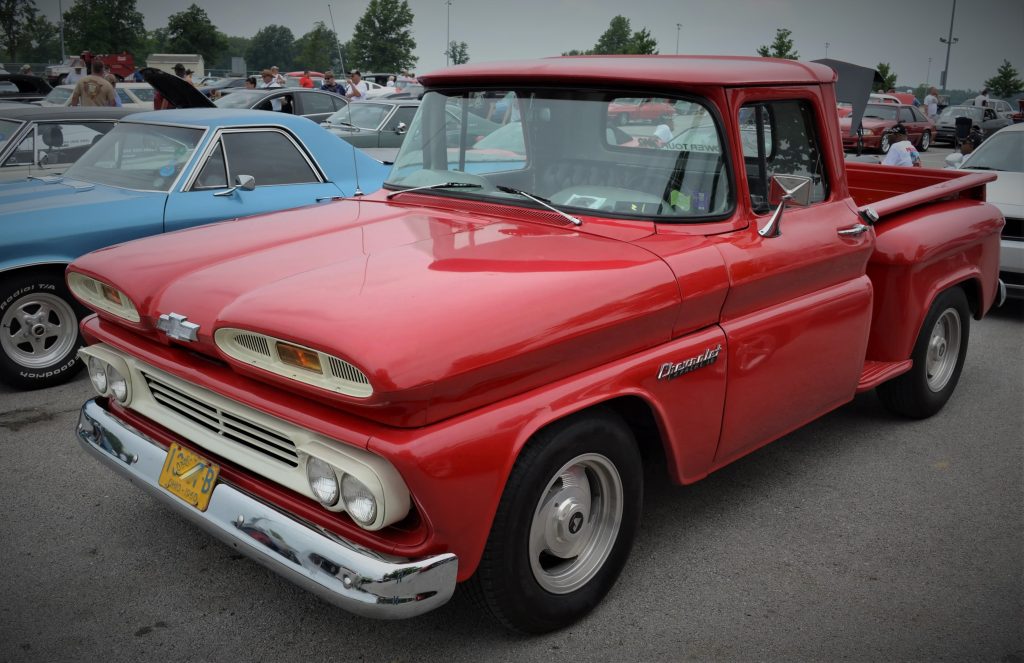When Chevrolet introduced its new “Advance Design” truck back in 1947, the “advance” part wasn’t just clever advertising hyperbole—the truck itself was a quantum leap in refinement and capability over GM’s earlier pre-war offerings.
And the styling? Well, let’s just say if you ask someone to picture an old-timey pickup truck in their head, there’s a good chance they’re picturing a Chevy Advance Design.

But by the mid 1950s, the Advance Design had advanced far enough, and Chevy debuted an all-new truck for 1955.
Dubbed the “Task Force” line, these trucks were still derived from the GM A-body chassis that dated back to the 1920s. They carried on a similar naming convention used in the earlier Advance Design models too, with 3100 denoting a light duty 1/2-ton short bed and 3200 reserved for the long bed version. 3600 and 3800 were used on the 3/4- and 1-ton trucks, respectively.
In 1958 the numerical sequence starting being phased out in favor of more dynamic names like Apache (3100), Viking (3600), and Spartan (3800).

Curiously, the new Task Force trucks were launched midway through 1955 and were sold alongside the outgoing 1955 Advance Design models. (The model overlap isn’t that unusual in the automotive industry though—heck, Dodge did the same thing with the Dart and Aspen two decades later.)
And just like the Advance Design of which it replaced, the new Task Force trucks were a giant push forward in truck design and capability.
For starters, trucks in the Task Force series could be equipped with the first-generation small block Chevy V8. The soon-to-be-legendary SBC powerplant bowed with a 265ci displacement and joined the venerable Chevy inline six engine on the options sheet.

Other refinements were baked into the Task Force recipe too, notably a 12-volt electric system and optional power steering, power brakes, and an automatic transmission.
The styling was revolutionary as well, with wraparound glass to improve visibility in the cockpit and a more streamlined, modern grill and headlight treatment.

The Task Force line also brought with it the Cameo submodel. The Cameo boasted car-like refinements and sleeker styling to cater to a broader truck market. More importantly, it featured a unique fiberglass bed and rear tailgate design that gave the Cameo a modern, streamlined appearance.
In other words, the Cameo helped foreshadow the shift from utilitarian workhorse rigs to today’s posh modern trucks and SUVs.

When the original Advance Design trucks reached iconic status in the collectors and hot rodders arenas, the Task Force generation wasn’t far behind.
And considering how easy it is to modify one of these classic haulers, when we saw this near-stock 1955 model pull into the Summit Racing Retail Store parking lot, we knew it had to be a Lot Shots feature.

We’re not entirely sure the painted wheels are stock—but they look darn good. All the chrome and bodywork was spotless as well, so it’s clear this is a well-cared-for truck.
Alas, we couldn’t track down its owner to get details on the drivetrain.

We do however, know this particular truck is a 1955 model, thanks to the placement of the fender badge—in 1956, it moved above the beltline crease.
Another easy clue is the smaller hood emblem, which increased in size (with longer side spears) for 1956 too.

As the 1950s came to a close, so did the Task Force era. In 1960, Chevy debuted its new truck design—one that finally shed its ancient A-body underpinnings that dated back to Calvin Coolidge.
The new trucks ditched the final remnants of the 3100-series numerical designations too, in favor of the now-familiar C- and K-Series monikers—though the Apache title stuck around for a few more years.
More importantly, the new first-generation C-/K-series trucks would establish GM’s truck design language for the next decade and set the stage for the fabled “Squarebody” trucks to arrive in the early 1970s.


Comments